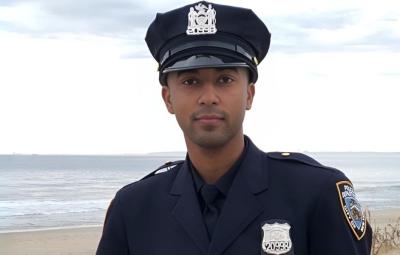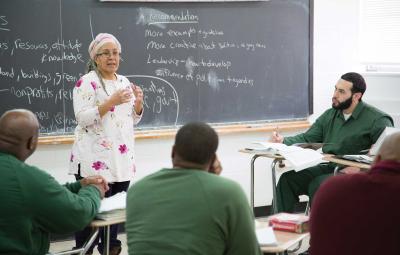
When he first immigrated to the United States from Sarande, Albania at 18 years old, alumnus and current graduate student Peter Mets ’20 didn’t have any family or friends that he could rely on, he didn’t speak English, and he’d never been involved in an academic research project. But all of that changed when he came to John Jay. “At first, it was very difficult. But John Jay became my home, and my professors and classmates became like family,” says Mets, who’s pursuing a master’s degree in International Criminal Justice. What made him want to travel halfway across the world? John Jay College’s reputation in the criminal justice field and the many research opportunities that the college offered. “In Albania they don’t have a criminal justice program,” he says. “I only applied to John Jay and I think I made a good choice.” Now, he’s contributing valuable field research that explores the impact of drug use within some of our most vulnerable populations.
“At first, it was very difficult. But John Jay became my home, and my professors and classmates became like family.”—Peter Mets
Interdisciplinary Research
In 2016, as part of his undergraduate capstone for Criminal Justice, Mets was introduced to John Jay Assistant Professor of Forensic Toxicology, Marta Concheiro-Guisan, Ph.D., who had received approval from the CUNY Human Research Protection Program (HRPP), also known as the Institutional Review Board (IRB), for working with the HIV infected homeless population in her study on the chemical components of synthetic marijuana, locally identified as K2, in drug users. Initially, the study theorized that individuals treated with HIV medications, and possibly mixing it with K2, could result in a fatal overdose. “K2 was a big issue in 2016,” says Mets. “There were plenty of articles in the New York Times talking about people overdosing all over the five boroughs. K2 was not like the marijuana plant. Creators of the drug were putting different kinds of chemical components in it which changed very often. At that time no one knew what was inside of K2,” says Mets, noting that in some parts of the five boroughs K2 was being sold legally. “This became a bigger issue after there was something like 33 overdoses in Brooklyn from K2 users. Media outlets brought this to the attention of the public, which led policy makers to change the law and to make it illegal. That’s how the opportunity arose to do more research to see what is actually going on. I collaborated with Dr. Concheiro-Guisan and her team in an interdisciplinary kind of research.”
“K2 was not like the marijuana plant. Creators of the drug were putting different kinds of chemical components in it which changed very often. At that time no one knew what was inside of K2.”—Peter Mets
Finding His Footing
Reflecting on how he felt when he first began working as a research assistant, Mets recalls some of the challenges and nerves he had to overcome. “I had never done this type of work before. In the beginning, research on this population felt like a whole other world for me. I grew up in a very small city, and homelessness wasn’t such a prevalent issue. I knew five people that were homeless and that was it. It was never talked about in the media,” Mets says. “I thought that I couldn’t do it at first because the participants were very unfamiliar to me.” But ultimately, Mets understood the challenges the participants were facing, and he felt responsible for their well-being. “Because I was working with this population, I completed the Naloxone overdose training at John Jay, and that gave me much more confidence.” Naloxone, also known as Narcan, is a medicine administered via injection to reverse the effects of opioid use during an overdose. “I worried about a participant overdosing right in front of me, and I was anxious about how I’d react, but the goal was always to make sure that everyone stayed safe,” says Mets. While he never had to use his training, he was prepared to help if the occasion did arise.
Overcoming Challenges
Armed with a new sense of confidence, Mets moved forward with the project. The first hurdle arose in finding the targeted population for the research, which led the team to the BOOM!Health Harm Reduction Center in the Bronx. “The whole objective of the study was to compare the urine and oral fluids as biological samples to monitor drug exposure among HIV infected homeless individuals. It was difficult to find homeless individuals who fit those specific requirements, so through the connection of another professor, we approached BOOM!Health and the initial objective changed. Not all of the participants were homeless individuals and not all were HIV infected individuals, but all of the participants were drug users. BOOM!Health gave us office space and recommended participants through their harm reduction program.” After setting up an office space at BOOM!Health, Mets spent three months interviewing and collecting fluid samples from participants. “I collected 70 samples of urine and oral fluid samples from 13 different participants. And, what we found in the sample was cannabis, benzodiazepines, cocaine, and other kinds of drugs.” Collecting data from participants in the field presented many challenges. “Throughout the study, we lost participants,” says Mets, revealing that study began with 20 participants and dwindled to 13 participants due to arrests, out of state relocation, and in the worst-case scenario, participants fatally overdosing.
“The whole objective of the study was to compare the urine and oral fluids as biological samples to monitor drug exposure among HIV infected homeless individuals.”—Peter Mets
Working with Professor Concheiro-Guisan
Because of the interdisciplinary nature of the research, Mets often communicated with project leader Concheiro-Guisan over the phone and in-person to exchange experiences. “We were educating each other. When we started the research, not a lot of research was done on the kinds of chemicals that were inside of the K2. For everyone who works in harm reduction and works with drug users, the goal is to integrate them back into society. So, we wanted to find out what was being put inside of these drugs and how we can help users,” Mets says. “I would tell her about my part and what I do, and she would tell me about what she does. She didn’t know about what was happening in the field, and I didn’t know what was happening with data that was sent to the lab. Our conversations were always fascinating.” Six months after the completion of the project, the findings were published in the Current Pharmaceutical Biotechnology journal.
“I would tell her about my part and what I do, and she would tell me about what she does. She didn’t know about what was happening in the field, and I didn’t know what was happening with data that was sent to the lab.”—Peter Mets
Continuing Research as a Graduate Student
“After learning more in the master’s program, I am now more interested in researching drugs and other areas of crime,” Mets says, citing his initial participation in Concheiro-Guisan’s study as the catalyst for his appreciation of research. “I am interested particularly in organized crime and human trafficking. This is the area I would like to research in the future. But a lot of research that I was starting this year has been put on hold because of the pandemic.” One collaborative project he’s excited to start working on is with Associate Professor of Economics, Christian Parenti, Ph.D., focusing on the continuing use and effects of K2 in drug users. “For his class, I decided to write about K2 and my research experience. Together we’re interested in doing more research on the current issues and events surrounding this drug,” Mets says.
“Everyone at John Jay is like a big extended family so I think that students should be confident in reaching out to professors for research opportunities. ”—Peter Mets
Recommending Collaborative Research
For students at John Jay who may be feeling hesitant to reach out to a professor about collaborative research, Mets highly recommends making the connection and exploring the possibilities. “Everyone at John Jay is like a big extended family, so I think that students should be confident in reaching out to professors for research opportunities. They are all great, especially the professors who do research. They love when they get emails from students that want to participate because they need people for their research projects and the students need the research experience to help develop their careers. If a student is interested in research, they should look into the professor to see what kind of research they are doing,” he advises. Mets believe that finding a professor with whom your interests align is the key component to beginning research, and that John Jay professors are excited at the prospect of collaborating with students. “When I did my research, I would tell the professor, ‘I know other students who would like to be part of your project,’ and the professor would say, ‘Okay, tell them all to come. They can all learn from this and put it on their resumes.’ And don’t believe that you have to have a background in science or research to contribute because a lot of research involves interdisciplinary studies.” His final piece of advice to all John Jay students: “Send that email.”



